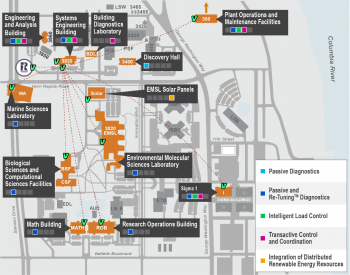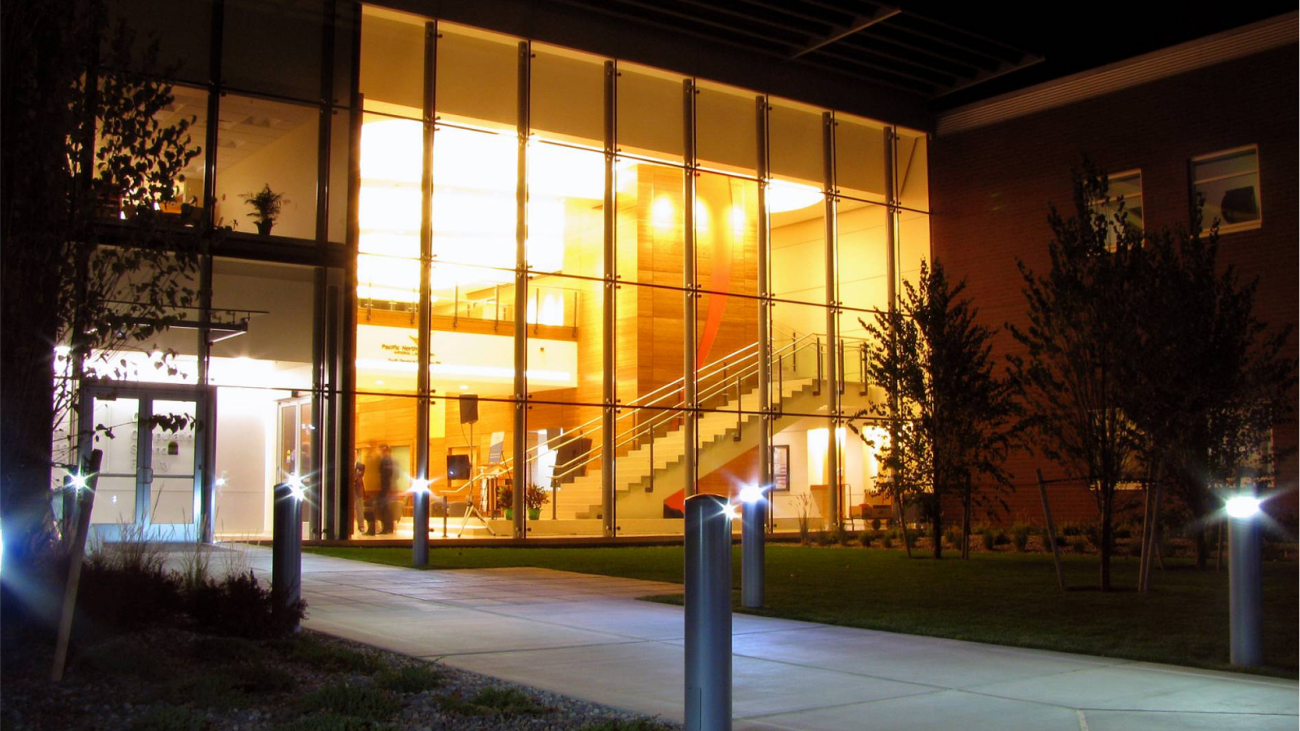
Clean Energy and Transactive Campus (CETC)


Partners: Pacific Northwest National Laboratory (PNNL), Avista Energy, McKinstry, Edo, University of Toledo, Washington State Clean Energy Fund, and the U.S. Department of Energy (DOE)
Connected Community type: Mixed use buildings (offices and labs) and university campus buildings
Distributed energy resources (DERs) installed: At the Richland, WA campus are solar panels totaling 120 kW, approximately 550 ton-hours of thermal (ice) energy storage, a 125 kW/200 kWh lithium-ion battery system, and electric vehicle charging stations. At the Toledo, OH campus is 1 MW of solar photovoltaic (PV), a 125 kW/130 kWh battery energy storage system, and an electric vehicle (EV) charging station
Flexible loads: The assets being controlled through building automation systems (BASs) include thermostats, rooftop units (RTUs), variable-air-volume boxes, air-handling units (AHUs), chillers, water heaters, thermal and battery storage, connected lighting, and EV chargers.
Control and coordination: The project uses Eclipse VOLTTRON™, an open-source distributed sensing and control software platform developed at PNNL, to control and coordinate DERs, including flexible loads across buildings. This agent-based control system works together with or without an existing BAS to deliver both energy efficiency and grid services. For grid services, two different approaches are used: (1) top down and (2) bottom up. In the top-down approach, a dynamic target is assigned at the building level and the building consumption/peak is managed to that target. In the bottom-up approach, each DER establishes its flexibility as a function of price and when a price is cleared, the DER are managed to the capacity that is reflective of that price.
Technologies developed and tested: (1) intelligent load controls (ILC), which employ PNNL-developed algorithms to manage and coordinate DERs, including flexible loads to manage building consumption; (2) transactive control and coordination (TCC) software to create energy markets both within and outside a building; (3) passive and active diagnostics to detect operational faults in AHUs and RTUs; and (4) automated identification of building Re-tuning™ or retro-commissioning opportunities.
Value proposition: The utilities are interested in better prediction of distributed generation resources in this disparate landscape of transactive energy campuses, reducing costs using flexible loads, reducing their reserve margin, enhancing reliability and resiliency, and scaling up for the future. Building owners are interested in utility bill savings with reduced building operation costs, enhancing reliability from improved grid stability, and maintaining occupant comfort. To an aggregator or “transactive” service provider, the revenue from service fees is an important value proposition.
Energy efficiency issues addressed: The energy efficiency technologies are intended to improve building operating efficiency. The technologies provide actionable information the building operator can use to correct or implement operations.
Grid issues addressed: The key goal of this research is to develop technologies that allow integration of renewables at both local and regional scales without affecting grid reliability by using ILC and TCC technologies to coordinate large numbers of DERs. One objective for this project is to demonstrate how a transactive energy structure that is able to manage its load flexibility can alleviate grid congestion and improve reliability as well as improve predictability with DER resources.
Grid services: The project focus was managing variable renewable energy integration and improving resilience and reliability at the building and campus levels by delivering energy and capacity services.
Utility programs or tariff use cases: The project tested and validated a number of grid service use cases, including peak load management, capacity bidding, real-time pricing, time-of-use, critical peak pricing, and transactive controls.
Occupant experience: Although no surveys of occupants were conducted, the project ensured that the zone comfort at times was within the accepted ASHRAE Standard 55 comfort zone and within the limits set by the facilities personnel.
Replicability and scalability: The approaches tested in the project can be replicable and scalable. However, more work is needed to make deployment of the technologies easier (i.e., reduce the complexity of configuration and increase automation) and to reduce uncertainty in models that estimate flexibility.
Project team leadership and coordination: The project is led by PNNL and both the energy efficiency and grid services technologies were developed by PNNL. Initial testing and validation of the technologies and use cases were conducted using simulation or emulation and then conducted on the PNNL campus buildings. The University of Toledo is helping PNNL test the technologies independently on its campus. In addition, PNNL is working with Avista, McKinstry, and Edo to test the technologies in the field.
Experience/highlight: This project is unique for the transactive energy systems approach to managing and coordinating DERs across a multitude of college campus buildings in Washington and Ohio. The agent-based approach to controlling the resources and loads using the VOLTTRONTM platform is seen as an opportunity to maximize profits and address scalability. This optimization occurs at all levels of the grid system from within the building up to the transmission system. A key objective for this project is to develop a “recipe for replication” for these transactive control systems to help building owners and aggregators more easily replicate this approach. To help facilitate this, the software developed as part of this project, including the reference designs, are open source, which benefits building owners, aggregators, and other researchers.


